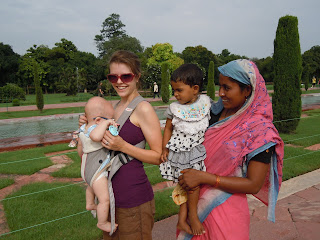Oliver continues to be a stud. Honestly, I don’t know what he’ll do when we move out of this guest house. There are approximately 15 (mostly) beautiful Indian women living here now, and they all like to flock around him and ooo and ahh and give him kisses and hold him, etc. Seriously, what more could a little guy ask for?
As we traveled around with Mom, we were sometimes overwhelmed by people, both Indians and other foreigners, who wanted to take his picture and in some cases, hold him. I had to become quite selective in whose requests for Oliver pictures were granted. I imagine that thousands and thousands of people have seen pictures of Oliver. There were days when I was so overwhelmed by being approached by nearly everybody that we saw that I just wanted to hole up and yell at everyone who looked my way. One day I did just that—hole up, I mean, after being surrounded by a sea (seriously, a sea, like 150) teenaged students.
While Mom was here, we visited Agra (the home of the Taj Mahal), Jaipur, and Jaisalmer. (More about the travels soon.) While in Jaipur, we happened across a man with a nice camera claiming to be a journalist who needed a picture for the front page of a special “Tourist-Day” edition that was going to run the next day. I say “claiming” because I’ve had so many experiences of being fed complete sh*t. We let him take the picture and sure enough, it was on the front page of a Hindi-language newspaper that circulates across the entire state of Rajasthan. I think it’s safe to say that Oliver’s fan club jumped into the millions overnightJ.
Oliver has started to babble and is eating more pureed food every day. He loves bananas, mangos, apples, pears, green beans, carrots, and peas. Being in India has forced me to make homemade baby food since the imported Gerber’s is the only baby food available in stores, and it’s expensive. When we were in Agra, he ate an entire mashed banana mixed with an equal portion of porridge in one sitting! He sits up fairly well by himself, and is getting closer and closer to crawling. He likes to spend more time on his belly, and is at the point where he scoots backward. He loves playing with the crunchy, plastic packs of diaper wipes, my bright pink neck pillow, sheer dupattas, and books (he hits at them and chews on the cardboard ones). One night when we were in Jaisalmer, he fell asleep playing with brightly colored, silky pillows. What a squirt! Enjoy the pictures of Oliver with his public…




